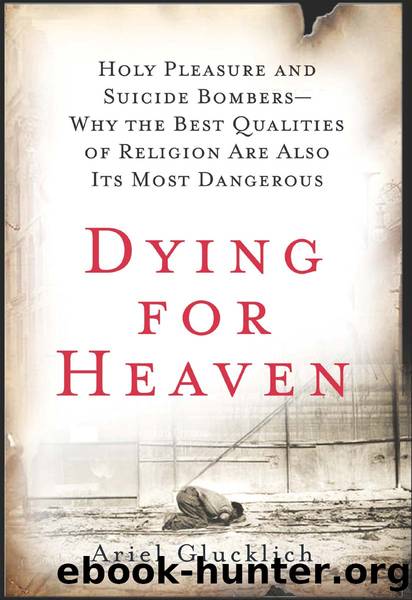Dying for Heaven by Ariel Glucklich

Author:Ariel Glucklich
Language: eng
Format: epub
Publisher: HarperCollins
Published: 2009-10-15T00:00:00+00:00
O Eternal Truth and True Love and Beloved Eternity! You are my God, to you I sigh day and nightâ¦. And you beat back the weakness of my gaze, powerfully blazing into me, and I trembled with love and dread.49
These mystics were motivated to seek God by intense love, which helped them summon the energy to focus attention and discipline a feeble will to the point where they could later describe the ultimate reward: Godâs overwhelming love in return. Where did that love truly come from? Must we assume that either God exists (and flooded them with love) or all of these mystics were âdelusionalâ (in the language of Richard Dawkins)? I shall assume that their reports were accurateâthat they were not imagining the love about which they wrote. At the same time I shall also leave God (whatever that term means) out of the explanation for the feeling they reported. Keeping things natural, I shall argue that the love that mystics feel radiating from God and entering their very being is the product of the Prozac effect: it is most likely a case of attribution to an intense joy, interpreted in light of the mysticsâ own feelings of love for God.
The key to the love of Godâand indirectly to the theory that God is loveâis the verticality (or invisibility) of pleasure and the mysticâs own feelings of love. What kind of love is that? What, indeed, is love? Does the mystic love like a parent, a friend, a lover? Contemporary psychologists divide love according to a number of taxonomies in order to explain its different social and biological functions, while accounting for the distinct neurological pathways that underlie each function. Ellen Berscheid, for example, distinguishes within the broad category of love the following subcategories: attachment, compassionate, companionate, romantic, and lust.50 The first, for example, is evolutionâs way of guaranteeing an innate attachment to a caregiver who is essential for survival. The second, which is Abraham Maslowâs famous âB-love,â is also an evolutionary product geared toward caregiving and social support. According to Clyde Hendrick and Susan S. Hendrick, romantic love itself can be divided into a number of âstyles.â51 This taxonomy includes eros (physical attraction), ludus (love as game), storge (friendship), pragma (matchmaking for useful qualities), mania (unhealthy mood swings), and agape (self-sacrificing love).
Despite these eccentric-sounding names, most contemporary psychologists of love agree that the categories or styles of love transcend cultural differences. Granted that different child-rearing practices along with varying ecologies and economies cause distinct cultural approaches to love, it is still possible to speak of universal and biological foundations. It seems then that both evolutionary and neurological theories of love represent a sensible approach to explaining the love that a mystic may feel toward the âdesired object.â
Although some mystical writings give the appearance of erotic or lust-driven love, I shall assume that this is a literary device. Furthermore, although leading psychologists, beginning with Freudâs nineteenth-century mentor Jean-Martin Charcot, have not shied away from exposing the sexual underpinning of mystical desire, I shall stay away from this singular reduction.
Download
This site does not store any files on its server. We only index and link to content provided by other sites. Please contact the content providers to delete copyright contents if any and email us, we'll remove relevant links or contents immediately.
The Lost Art of Listening by Michael P. Nichols(7409)
Why I Am Not A Calvinist by Dr. Peter S. Ruckman(4103)
The Rosicrucians by Christopher McIntosh(3467)
Wicca: a guide for the solitary practitioner by Scott Cunningham(3127)
Signature in the Cell: DNA and the Evidence for Intelligent Design by Stephen C. Meyer(3071)
Real Sex by Lauren F. Winner(2968)
The Holy Spirit by Billy Graham(2893)
To Light a Sacred Flame by Silver RavenWolf(2768)
The End of Faith by Sam Harris(2691)
The Gnostic Gospels by Pagels Elaine(2472)
Waking Up by Sam Harris(2392)
Nine Parts of Desire by Geraldine Brooks(2326)
Jesus by Paul Johnson(2310)
Devil, The by Almond Philip C(2282)
The God delusion by Richard Dawkins(2265)
Heavens on Earth by Michael Shermer(2238)
Kundalini by Gopi Krishna(2137)
Chosen by God by R. C. Sproul(2123)
The Nature of Consciousness by Rupert Spira(2047)
